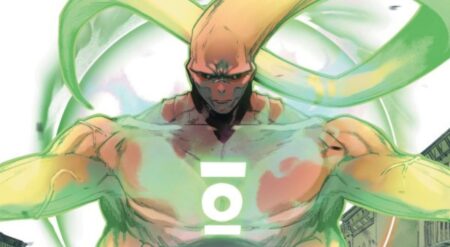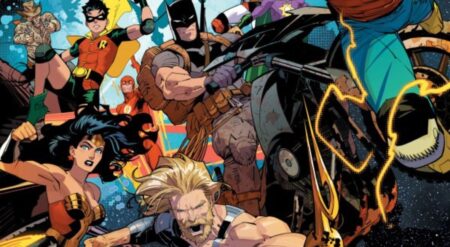
Man-Bat #3 is published by DC Comics. Written by Dave Wielgosz with art by Sumit Kumar. The colours are from Romulo Fajardo Jr and the letterer is Tom Napolitano.
In the first issue, Man-Bat attacked a group of robbers stealing a sonic cannon. As Batman intervenes, Langstrom damages the weapon, causing a sound explosion that damages several people’s hearing and puts others in a coma. Batman tells Kirk that the serum he takes to transform has done too much damage and is starting to kill him. Soon, it will be just Man-Bat in control. Langstrom escapes, attracting the attention of the Suicide Squad. Man-Bat battled the Squad and defeated them. But he didn’t account for Harley Quinn, who knocked him up and dragged him a room for a long-needed therapy session. And the true villain was revealed as Scarecrow starts to make a move.
The issue starts with Harley trying to dig into the mind of Man-Bat. She reveals to him how bad things can get for him, trying to encourage him to calm down and turn back. Turning back to his human form, Kirk realises he can’t run any longer. He travels to stay with his deaf sister, which spurred his obsession in the first place. But Scarecrow isn’t interested in Langstrom’s search for redemption…
The pace of this issue is much slower than the first two chapters, but that was very much needed. It works as a chance for the reader and story to breathe, the action making way for a lot of character development. The structure of this chapter allows for the pace to fluctuate. As the comic progresses, the intensity picks up again. The introduction of Scarecrow means someone else is hunting Kirk, and that can only result in his furry form getting involved. The fight is energetic and intense. Wielgosz has kept the story continuously fascinating, but repetition is also a technique that he uses often. The way the comic ends isn’t surprising, instead, it felt inevitable.
One of the primary criticisms in previous reviews of this series is that Kirk has always felt less developed than his Chiroptera identity. The scenes he was in were a preamble before the main event. But Man-Bat #3 changes this, taking time to explore what Kirk is really like. He is incredibly loving and devoted to his family. Harley recognises the good in him, as Batman and Deadshot did in previous comics. But he is also deeply troubled, and it is appreciated that Wielgosz didn’t have his dangerous attributes dissipate.
Man-Bat appears again and continues to capture the hearts of the reader. When he emerges it is often because he is in trouble and will often fight to protect or escape, as any animal would do. Man-Bat’s voice remains as captions when Kirk is human, and it is clear that it is starting to pull him away from the things that make him Kirk. Those close to him are there to trick and hurt, instead of help.
The dialogue has been great consistently in the last two parts of the series. But issue #3 and the use of Harley adds a different aspect to the conversations that haven’t been present yet. Wielgosz unleashes Quinn’s comedy beautifully as she is trying to tackle the mind of Kirk Langstrom. One of the funnier moments is how Harley can create these scenarios that may happen in the future, which result in these long diatribes. Whilst probably accurate in how they may occur, they are entirely in her head. Harley’s appearance and voice is really refreshing in such a loud and dark book.
The writer understands the incredibly complex character that is Harley Quinn. Within the “therapy session,” the readers are witness to her skills as a psychiatrist. Harley is a very intelligent person with a tactical mind, hence her ability to talk Kirk down. But she is also sensitive and kind, with violence and menace built-in as well. While appearing briefly, this is one of the best and most complete Harley moments in a long time.
Another important figure that appears in Man-Bat #3 is his sister, Lisa. Kirk started his research in order to find a cure for her deafness, something she doesn’t actually want. Since she is so important to his backstory, it was crucial for her to have a big impact in this story too. Their scenes together depict a close familial connection that her brother has tarnished and destroyed, using her deafness as an excuse for the damage he caused. Every character within this comic is detailed and powerful in their personalities.
The artist, Kumar, is a brilliant storyteller. So many details don’t have to be added in dialogue, as they are so visually evident. Kirk is wearing thin and losing himself, which is portrayed through his appearance. He is thin and scruffy, a result of not being able to stop in one place for long. But staying with his sister seems to ease that, as a few days with her causes him to straighten up. Some facial expressions, such as for Man-Bat, are brash and exaggerated, but many are subtle and quiet. At times it looks like Kirk is shaking with rage. And Harley has never looked scarier than when she threatens Langstrom if he hurts Francine.
This visual storytelling is prevalent in combat too. Despite the basic premise of his powers, he is a giant bat, each fight feels different and as exhilarating as ever. Man-Bat’s foes are constantly changing, from Batman to robbers to giant crocodiles and assassins. In this issue, he comes to blows with Scarecrow. The choreography of the fighting is superb. The design of Scarecrow is also fantastic, looking extra creepy within this series.
The colours are stunning, and add so much personality to each page. Fajardo Jr fades shades into each other beautifully, allowing for a diversity of textures and tones. Both Lisa and Harley have different colours in their hair that are depicted wonderfully. But there’s also a cloud of purple that covers Kirk in one scene as his rage intensifies. This is another example of how to show emotions and narrative changes without a character having to even speak.
The lettering is terrific. When humans speak, the text is small and easy to read. But the word balloons and text gets bigger and scratchier when Man-Bat is yelling. This showcases just how loud and fearsome he is, especially in a small space.
Man-Bat #3 is a result of brilliant storytelling, visually and literary. This is a superb exploration of one very specific character. Wielgosz’s examination of Man-Bat’s story and character has created a very emotional story. But there are also incredible battles and guest stars that feel warranted instead of obligatory. The art team of Kumar and Fajardo Jr present this with such precision that it could be followed without any dialogue at all.
Man-Bat #3 is available where comics are sold.
Man-Bat #3
TL;DR
Man-Bat #3 is a result of brilliant storytelling, visually and literary. This is a superb exploration of one very specific character. Wielgosz’s examination of Man-Bat’s story and character has created a very emotional story. But there are also incredible battles and guest stars that feel warranted instead of obligatory. The art team of Kumar and Fajardo Jr present this with such precision that it could be followed without any dialogue at all.







